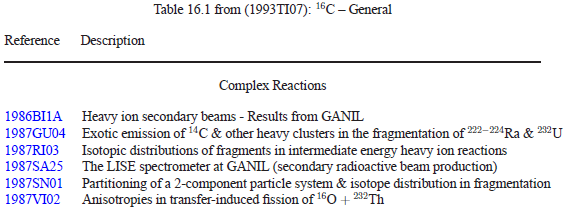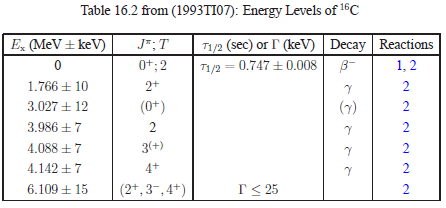Evaluation Home Page |
| Information on mass chains and nuclides |
|
|



16C (1993TI07)
(See Energy Level Diagrams for 16C)
GENERAL: See  16.1 [General Table] (in PDF or PS) and
16.1 [General Table] (in PDF or PS) and  16.2 [Table of Energy Levels] (in PDF or PS) here.
16.2 [Table of Energy Levels] (in PDF or PS) here.
| 1. 16C(β-)16N | Qm = 8.012 |
The half life of 16C is 0.747 ± 0.008 sec. It decays to
16N*(0.12, 3.35, 4.32) [Jπ = 0-, 1+,
1+]: see  16.3 (in PDF or PS) and (1993CH06). See also (1986AJ04) and see (1986KI05,
1988WA1E, 1992WA1L) for
theoretical discussions of extended shell-model calculations of
0+ → 0- transitions and determination of the
mesonic enhancements εmec of the
time-like component of the axial current. See also (1992TO04)
and see 16N, reaction 1.
16.3 (in PDF or PS) and (1993CH06). See also (1986AJ04) and see (1986KI05,
1988WA1E, 1992WA1L) for
theoretical discussions of extended shell-model calculations of
0+ → 0- transitions and determination of the
mesonic enhancements εmec of the
time-like component of the axial current. See also (1992TO04)
and see 16N, reaction 1.
| 2. 14C(t, p)16C | Qm = -3.013 |
States of 16C observed in this reaction are displayed in  16.2 (in PDF or PS). See also
16.2 (in PDF or PS). See also  16.3 (in
PDF or PS) of (1982AJ01).
16.3 (in
PDF or PS) of (1982AJ01).
| 3. 16O(K-, π+)Σ16C |
(1985BE31) used negative kaons of 450 MeV/c to produce Σ hypernuclear states, which they interpreted as Σ- particles in the p3/2 and p1/2 orbits of the Σ16C hypernucleus. Their energy splitting was used to constrain the Σ- spin-orbit coupling.
(1986HA26) performed a systematic shell-model analysis of Σ-hypernuclear states, in which they deduced a ΣN-spin-orbit interaction about twice as strong as the one for the nucleon. (1986MA1J) reached a similar conclusion after extracting the one-particle spin-orbit splitting εΣ = εΣp1/2 - εΣp3/2. (1987WU05) used the continuum shell-model to study competition between resonant and quasi-free Σ-hyeprnuclear production. The observed structures in the excitation spectra are essentially accounted for by the quasi-free mechanism alone. (1989DO1I) perform a series of shell model calculations of energy spectra of p-shell Σ hyeprnuclei, starting with several different parameterizations of the ΣN effective interaction. Production cross sections are estimated using DWBA. They suggest experiments to resolve open questions regarding the ΣN and Σ-nucleus interactions. (1989HA32) uses the recoil continuum shell model to calculate in-flight Σ hyernuclei production of this reaction (and others). The needed to modify the ΣN central interaction to fit data.
Coupled channels (CC) calculations for Σ-hypernuclear spectra give an energy integrated cross section which is about 1.7 times the experimental value (1987HA40). (1988HA44) report CC calculations emphasizing the proper treatment of the Σ continuum states. They find that a weak Σ central potential and a comparable ΣΛ conversion potential are required to describe experiment.
